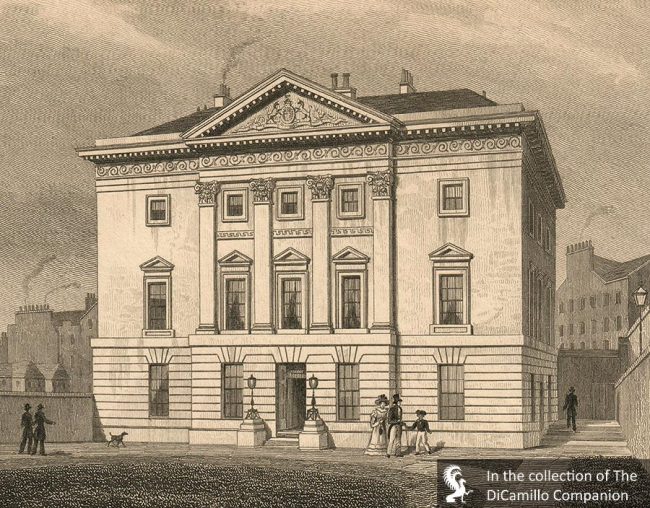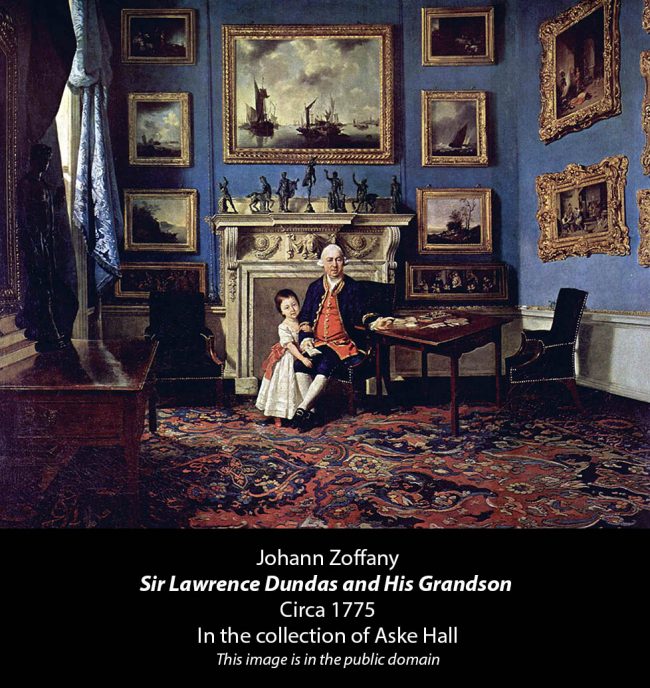
The house from an 1833 steel-engraved print

In this famous conversation piece, Sir Lawrence Dundas is shown in one of the Robert Adam-designed rooms of his London townhouse, 19 Arlington Street. Purchased by Sir Lawrence in 1763 for £15,000, 19 Arlington remained the Dundas family’s London home until it was demolished in 1936 and replaced by an apartment building.
Built / Designed For: Sir Lawrence Dundas, 1st Bt.
House & Family History: Sir Lawrence Dundas had a spectacularly successful career. The second son of Thomas Dundas, a draper from Perthshire, Lawrence began his professional life as a modestly successful wine merchant. He hit the big time in the 1750s, when he was appointed commissary general to the forces during the Seven Years' War. This position, in which he supplied goods to the British Army, enabled Lawrence to amass a great fortune, which he used to become a successful banker and Whig politician. Made a baronet in 1762, Sir Lawrence used his great wealth to buy houses and estates in England, Scotland, and Ireland. A member of the Society of Dilettanti, and a man of great taste, he formed large and important art collections at his houses and commissioned furniture and fittings from the finest makers of the day, including Thomas Chippendale, John Cobb, and William Vile (see “Images” section for Zoffany painting of Sir Lawrence and his grandson in his London townhouse). At his death in 1781, Sir Lawrence left his son an immense fortune of £900,000 (over £1 billion in 2019 inflation-adjusted values using the labour value commodity index). Sir Lawrence is buried in the Dundas Mausoleum at Falkirk Old Parish Church. In 1768 Sir Lawrence purchased the Peace and Plenty pub in an area of Edinburgh that would later be laid out as the New Town (built in stages between 1767 and 1850). Here he built a grand townhouse modeled on Marble Hill House, London, on a site originally intended for St. Andrew's Church (ultimately built at 13 George Street in 1784). In 1794 Dundas House was sold by Sir Lawrence's son to the government, who opened the building as Excise House in 1795 (it was during their occupancy that the royal coat of arms was added in the pediment). Dundas House was purchased by the Royal Bank of Scotland in 1825 for £35,300 (approximately £30 million in 2019 values using the labour value commodity index) and has remained the headquarters of the bank, and its successor, NatWest Group, ever since. The building's facade appeared on banknotes issued by the Royal Bank of Scotland in the 20th century.
Comments: In 1780 Hugo Arnot described Dundas House as "incomparably the handsomest townhouse we ever saw."
Architect: William Oldham Chambers
Date: 1771-74
Title: Biographical Dictionary of British Architects, 1600-1840, A - HARDBACK
Author: Colvin, Howard
Year Published: 2008
Reference: pg. 245
Publisher: New Haven: Yale University Press
ISBN: 9780300125085
Book Type: Hardback
House Listed: Category A
Park Listed: No Park
Past Seat / Home of: Sir Lawrence Dundas, 1st Bt., 1773-81; Sir Thomas Dundas, 2nd Bt. and 1st Baron Dundas, 1781-94.
Current Ownership Type: Corporation
Primary Current Ownership Use: Offices
Ownership Details: Owned by NatWest Group
House Open to Public: Yes
Historic Houses Member: No